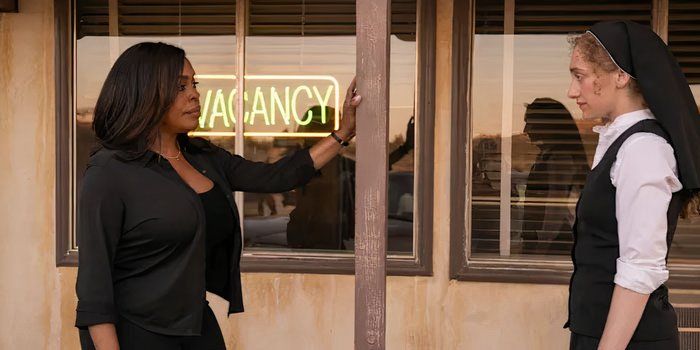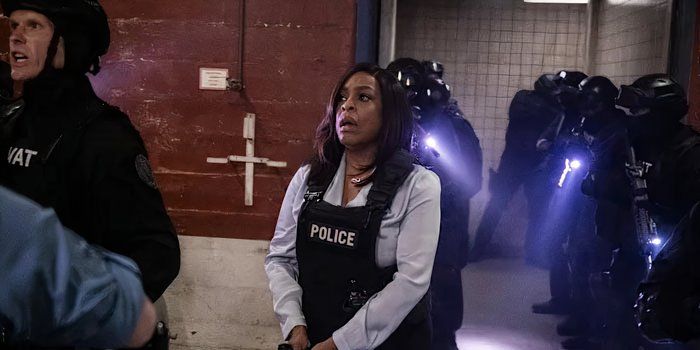
Warning: The following contains hints of violence, gore, and spoilers for Grotesquerie!
FX’s Grotesquerie Continues to make a splash with his unique take on a murder mystery format, adding a deeper layer with all the biblical references sprinkled throughout the show. The horror meets true-crime show by Ryan Murphy follows Detective Lois Tryon (Niecy Nash-Betts) as she investigates a series of gruesome murders staged after biblical scenes, and the case becomes increasingly personal. A local nun named Sister Megan Duvall (Mikaela Diamond) takes an interest in the case for her parish newspaper, and quickly forms a unique friendship with Detective Tryon.
The unlikely partnership between Grotesquerie The characters Lois and sister Megan serve as a guide to deciphering the show’s most (literally) grotesque crimes. From the seven deadly sins to clues that reference specific biblical verses and tropes, The show offers a glimpse into what happens when religion is taken too literally. These references continue to drive the plot of Grotesquerie and shed light on each character’s backstory.
7
The deadly sin of gluttony
Episode one sets up the ongoing motif of this deadly sin
Lois is introduced as an emotionally exhausted detective whose husband is in a coma and whose daughter struggles with binge eating as a coping mechanism for her family trauma in Grotesquerie Episode 1. The first crime scene is the horrific murder of the Burnside family, which Lois recalls are beloved members of the community and progressives who fought for social justice. Their youngest baby child was boiled in a pot, and the family’s father was “Salted and peppered, seasoned with fennel seed and cayenne and roasted for two hours in a 375-degree oven with sunchokes and baby carrots.”
The remaining family members were tied and forced to eat some of their father’s food, killing them from acute shock. The disturbingly intricate murder scene visibly disturbs the police officers on the case, and Lois struggles to discuss the baby’s fate when Sister Megan first appears to discuss the crime. When Sister Megan explains that she hopes to assist Lois in her investigation because she fears religious fanaticism is at play, It becomes clear that the initial crime scene is meant to reflect one of the biblical seven deadly sins of gluttony.
The murderer clearly feels that social progressives will figuratively “eat their own” eventually, a cruel end considering gluttony refers to greed or overindulgence. He chose a family known for its beliefs to convey his message, and he continues to follow this strategy throughout the show.
6
The Last Supper Entertainment
Grotesquerie is signaling to Lois that the end is near
Inside the church where Sister Megan and Father Charlie Mayhew (Nicolas Alexander Chavez) work, the killer infiltrates the altar and stages a series of murders to look like the biblical Last Supper. The Last Supper is what sparked the Catholic practice of communion, with bread and wine representing the body and blood of Jesus (via Bible study tools). The crime scene comes after Lois is repeatedly stalked in her home, and Its finality is intended to send you a message – that time is running out.
Adding to the themes of the Last Supper is another scene in Grotesquerie Episode 3 in which Lois cooks her daughter, Merritt Tryon (Raven Goodwin) a massive feast, asking her to overlook her alcoholism in return for overlooking her binge eating. This scene links the gluttony in episode 1 and the finality of the last supper in episode 2, leading to the conclusion that gluttony and overconsumption mean the end is near.
5
The deadly sin of lust
The show explores this theme in different ways in episode 3
The next victims are a group of exotic dancers and sex workers who Lois recalls saving from drug overdoses and illnesses. Sister Megan analyzes that the killer must “hate sex” And think of yourself as “A prophet trumpeting the coming of the end.” One of the victims’ heads was replaced with The head of a goat, mirroring a puzzle Lois completes in a flashback with her husband Marshall (Courtney B. Vance). The painting is a 1798 work by Francisco Goya titled “Sabbath of Witches”, made during the Spanish Inquisition, a time in which non-Christian men and women were severely punished..
The crime scene painting offered a flash of what Grotesquerie thinks of women and sexuality, and the deep contempt he holds for the sin. After the crime is reported, Sister Megan and Father Charlie give in to their desires and are intimate in the convent as she works on the article, after she learns about his side hustle as “The peddling priest.” The contrast of the killings and the moment between Charlie and Megan illustrates the danger of weeds, As it resulted in the death of sex workers and now potentially the destruction of Charlie and Megan’s lifestyles.
4
Bible verses
The coordinates found in the box lead to a biblical hellfire recreation
After Merritt cracks the code and opens the box left in another crime scene indicating lust, sisters Megan and Lois discover coordinates that take their partnership deep into the desert, at the site of a wildfire pit that is growing by the day. Sister Megan draws the conclusion that The killer sent them to the location to point out that Lewis is the reason he is spreading figurative hellfire. The juxtaposition between the purgatory-like state of Lois’ husband in a coma and the hellfire may also recall Dante’s HellA work of classic literature that explores the different layers of hell.
The juxtaposition between the purgatory-like state of Lois’ husband in a coma and the hellfire may also recall Dante’s HellA work of classic literature that explores the different layers of hell.
If the Hell The theory is true, Then, sisters Megan and Lois are in the seventh circle of violenceYet they have traveled through limbo, lust, gluttony, greed, anger, and potentially heresy after Megan and Charlie’s try. After Lois is frustrated by the wild goose chase, Sister Megan quotes Psalm 88:6-7, “You put me in the lowest pit, in the darkest depths. Your anger lies heavily on me; You surprised me with all your waves.”
3
Dante’s Inferno imagery
The whole show maintains a sense of limbo throughout
The hospital that holds Lois’ husband continues to haunt her thoughts, though it It remains unclear if the retro-style nurses and orderlies are figments of Lois’ drunken drive or a small desert town reality.. When Lois gets into a drunk driving accident and is hospitalized, an orderly named Ed (Travis Kelce in his Grotesquerie acting debut) helps her get home and later encourages her to seek treatment for her alcoholism as he once did.
While Eddie later interacts with Lois’ daughter Merritt as the pair become friends for the protection of the family as Lois is increasingly stalked, his sudden role in their lives feels divine. As part of the US Hell theory, Eddie may be intended to be the person to lead Lois out of the limbo she feels over her career and marriage.
2
The symbolism of the Judgment Day
The twin sisters of the apocalypse
As sisters Megan and Lois rush to escape the fires, they spot a young woman named Andrea (Victoria Abbott) drenched in blood in the middle of the road. Rescuing her, the group seeks refuge at the local motel on Andrea’s recommendation. The hotel has no phone service, and the television shows only programming from the fires, wars and the COVID-19 pandemic – all moments synonymous with “the end times”, or the biblical concept of Judgment Day.
Judgment Day refers to the last day of earth on which God is to judge all the sinners left. Given the religious theatrics of the titular Grotesquerie’s murder scenes, it’s very clear the show’s main killer Holds in contempt any marginalized or progressive people, and believes that they should be judged based on the state of the world.
1
Lois ‘Glorious’ Arrest
As “glorious” appears in religious texts
When the killer begins to include personal information about Lois in her elaborate crime scenes, Lois’ co-worker decides to revisit the previous criminals Lois has put behind bars. A pimp named Glorious who was imprisoned for life is mysteriously released, and is quoted regularly by a strange woman on the side of the road.
The name has a deeper meaning. The word “glory” is used throughout the Bible to describe God’s righteous attributes. As viewers learn, Glorious isn’t the killer, but she certainly knows something—in her case, Making her honorable quality she knows how to catch the culprit. In any case, the biblical motifs present in Grotesquerie Have some characters look suspicious, making the intricate symbolism noteworthy.
New episodes of Grotesquerie Drops on Thursdays on Hulu.
Sources: Bible study tools





